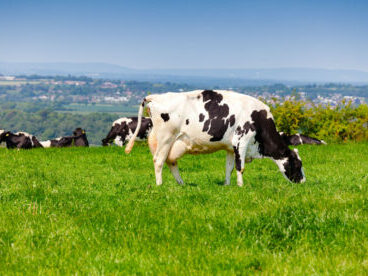Fats and oils have a vital role to play this winter to help cows be as efficient as possible
Feed optimum fats and oils for efficient healthy cows
Fats and oils have a vital role to play this winter to help cows be as efficient as possible: maximising cost-effective production while keeping them healthy and fertile. But, as independent nutritionist Dr Brian Vernon explains, all fats are not the same and it is crucial to provide the fats your cow needs: more specifically the right balance of individual fatty acids.
Fats and oils are an efficient and effective source of energy for dairy cows that will help to meet the energy demands for today’s higher yielding animals and, for example, reducing the consequences of negative energy balance (NEB)
If we can limit NEB we will increase milk production while also improving fertility thereby reducing the costs of not getting cows back into calf quickly. In addition, dietary fats/oils have a significant impact on milk quality, helping to reduce the impact of falling milk prices.
It is important, however, to understand that fats are used in different ways by the cow. We need to feed the right fats in the right form to deliver the results. Get it wrong and feed costs will increase with no improvement in performance, the last thing any dairy farmer wants.
The first point, we all know, is that the rumen is king. We must do our utmost to keep it healthy, as this engine impacts on maintenance, fertility, NEB, milk yield and compositional quality. We need to maximise fibre fermentation to make full use of forages, our cheapest component in diets, as it usually constitutes over 60% of total dry matter intake.
Rumen health
NDF fermentation is important for rumen health and efficiency. More recent research data indicates that in high yielding dairy cows VFAs from NDF fermentation only provide approx. 25% of milk fat production. Thus, added fats are vital to balance any shortfalls in energy supply. Unfortunately, fats can be degraded in the rumen and this is not a good thing. This degradation will readily compromise rumen fibre fermentation, leading to reduced rumen efficiency, depressed forage intakes and lower production from the total diet. To maintain an effective rumen, you must ensure that the added fats are rumen inert: ie they pass through the rumen and remain undegraded. Post rumen, the key is to ensure that the right balance of fatty acids is available for efficient use by the cow: this becomes more critical as milk yield increases.
Energy absorption
Fats/fatty acids are digested and absorbed in the small intestine. Fatty acids, however, are not digested at the same rate. Saturated fatty acids have a digestibility approximately half that of unsaturated fatty acids (99%). To optimise the digestion of fats, your cows require a balanced mixture of these fatty acids.
The absorption of a balanced fatty acid mixture is vital as cows use energy for maintenance first, followed by milk production, immunity and then other demands. Imbalance this supply and cows will, for example, be in NEB much longer. C16 fats are interesting in that their fatty acids go straight to the udder: hence higher milk fat. This results in a metabolic shortfall in energy supply and balance. The cow now breaks down body tissues to rebalance her needs, increasing NEB and body condition loss. Thus, one outcome is that the energy of the total diet has been over-estimated.
Furthermore, this ‘maintenance first’ requires the cow to consume essential unsaturated fatty acids: C18:1 (oleic), C18:2 (linoleic) and C18:3 (linolenic). These are critical for controlling NEB and assisting the immunity/health status of the cow. C16 fats do not supply these essential fatty acids. In addition, the inclusion of marine oils supplying the omega 3 oils DHA and EPA can help improve fertility and health.
Boosting butterfat
In times of downward price pressure, a key advantage of feeding additional by-pass fats is to increase butterfat.
Up to 69% of the fats in milk are saturated fatty acids and these primarily come from the diet, with a low level from NDF fermentation. Since approx. 25% of butterfat comes from rumen VFA production, then it is essential to provide dietary fats to maximise butterfat production.
The fatty acid profile of butterfat is relatively consistent.
25% short chain fatty acids (C4-C14)
30% C16:0 saturated fatty acid
11% C18:0 saturated fatty acid
33% unsaturated fatty acids (C18:1 etc).
This profile further highlights the need for a balanced supply of fatty acids. But, C16 fats/fatty acids are directed to the udder.
To increase milk butterfat therefore requires the other fatty acids as well. Under supply of C18:0 and the other unsaturated fatty acids, with ‘maintenance first’, means feeding C16 fats alone will not increase butterfat yields as C16:0 only represents 30% of the butterfat.
What does this all mean in practice?
In simple terms, fats have the potential to be an exceedingly valuable component in your diets this winter: to help increase energy intakes thereby making the best use of forage and support milk prices/margins. The benefits are medium and long term: improving production and fertility now plus the reductions in NEB and body condition loss will set the cow up right for her next lactation.
But, remember that all fats are not the same. You need to feed a balance mixture of fatty acids that can be effectively utilised by the cow in all stages of lactation and pregnancy. The failure to do so can lead to a disappointing response and reduced margins.
My advice would be:
Focus on rumen health first: without this, added dietary fats will not give you the best results. Fats are not a ‘band-aid’ for an ineffective base diet.
Ensure any added fat is rumen inert so as not to disrupt fibre fermentation
Feed a blend of fats. Single C16 products do not deliver the most effective metabolic response
Ensure that you supply the essential C18 unsaturated fatty acids: they are vital components in all of the cow’s metabolic systems and any shortage will lead to significant problems.
Add DHA and EPA, from marine sources, to help improve overall fertility and herd health as well as boosting the immune system.


 Back to News
Back to News 



